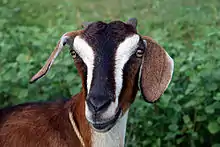 | |
| Country of origin | India |
|---|---|
| Traits | |
| Weight |
|
| Skin colour | White, brown and piebald |
| Wool colour | White, brown and piebald |
| Face colour | White, brown and piebald |
| |
Malabari goats are bred in Malabar district of Kerala, and are sometimes called Tellicherry goats.[1] They are bred mostly for meat, but it also produces milk. Females weigh an average of 30.68kg while males weigh 41.20kg, and their coats are white, black, or piebald.[2] Although they are similar to the Beetal goat, Malabari goats weigh less, have shorter ears and legs, and have larger testicles.[3] There was an effort to crossbreed the Malabari goats with Boer goats, but this practice is controversial.[1][4]
References
- 1 2 "'Malabari' goats under threat of extinction". The Hindu. 2002-12-16. Archived from the original on 2003-04-05. Retrieved 2018-08-29.
- ↑ Verma, N; Dixit, S P; Dangi, P.s; Aggarwal, Rajeev; Kumar, Santhu; Joshi, B.K. (1 August 2009). "Malabari goats: Characterization, management, performance and genetic variability". Indian Journal of Animal Sciences. 79: 813–818 – via ResearchGate.
- ↑ Bilaspuri, G.S.; Singh, K. (1993-04-01). "Distinction between Malabari and Beetal goat breeds". Small Ruminant Research. 10 (3): 201–208. doi:10.1016/0921-4488(93)90124-Z. ISSN 0921-4488.
- ↑ "Malabari Goats | Vechur Conservation Trust". vechur.org. Retrieved 2018-08-29.
This article is issued from Wikipedia. The text is licensed under Creative Commons - Attribution - Sharealike. Additional terms may apply for the media files.